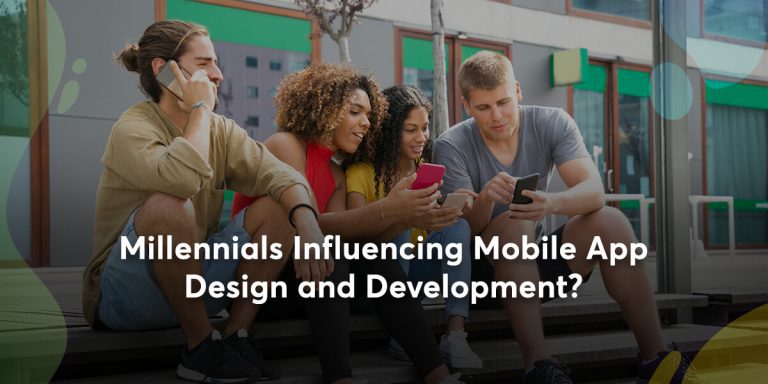With the shifting passage of time and the increasing rate of technology breakthroughs in recent years, millennials and youngsters seem to be smarter than people of earlier generations.
Now, teens make up a considerable audience for all mobile apps put together, and for specific niches, they play the leading role as an audience.
Most importantly, millennials and young audiences are often great payers or key contributors behind the financial success of apps. This is precisely why marketers around the world are increasingly trying to target millennials.
With so much focus on millennials and developers around the world trying so hard to tweak their apps for this audience, it is no longer an overstatement that millennials are shaping the mobile app’s design and development.
But how is this taking place? How are millennials transforming mobile app development and design?
Mobile App Design and Development:
Let us explain some key findings!
A Modified Approach to App Content
The way millennials make use of regular content gives the most significant impetus for change. For example, millennials are smarter enough to follow social media content that interests them personally. They use hashtags to find out what they need while just ignoring the rest.
Instead of the traditional approach of browsing the pages and picking something interesting in between, they prefer only giving their attention in one place where they find all their needs in one place.
This typical focus on individual interests and preferences also made content marketers think about how they can cater to people effortlessly and more smartly.
Well, from Netflix to YouTube to Facebook, all platforms are now using smart algorithms to showcase content by giving priority to individual preferences based on earlier search behavior and interactions.
Another vital attribute of the content consumption by millennials can be viewed in the way they behave restlessly by fast-forwarding video content while only grabbing a handful of crucial portions to make a quick opinion.
In the same manner, millennials are strongly against reading long text content, and often they prefer grabbing byte-sized content that can be viewed at a glance.
This attitude is increasingly making content marketers and apps use small byte-sized content, whether in text or video, instead of lengthy ones.
Designs for Functional Ease
The earlier design was loosely related to functions and features. At best, web and app design used to be viewed as elements to optimize readability and make use of the website or app simpler. Now, thanks to millennials and their smarter approach, the design is more attached to functional ease and overall user experience than ever before.
Since today’s millennial audience is always restless, and they try to do things in a whiz, the design elements should help those complete actions faster on screen.
Design elements no longer serve the purpose of grabbing attention and making users engaged. They increasingly play a pivotal role in allowing fast-paced interactions.
For example, while most millennials now prefer holding phones single-handedly while browsing on-screen content with a thumb, app designers now mostly place important links and tap targets within reach of the thumb to ensure easy and effortless interaction.
Visual Data
For many users, apart from the functions and features, it is the information that primarily makes them use an app. Since allowing access to data is a crucial value proposition for many apps across niches, data visualization is increasingly being used by apps to make apps more usable and effective for practical contexts and use cases.
Moreover, data visualization is also gaining momentum thanks to millennials who always prefer to stay advanced and updated in terms of technology.
Data analytics are increasingly allowing them to dig out more potential outside data to help well-informed and data-driven interactions.
Personalization of User Experience
Today’s millennials always look for distinct personality attributes, whether in their choice of fashion apparel or mobile games that help them appear trendy over others.
This constant search for an authentic stamp for individuality in almost everything makes them also prefer mobile apps with a broader scope of personalization.
This is why any app allowing them to showcase their choices, create their distinct presence, and make use of personal freedom instantly becomes popular among these millennials. The popularity of Spotify, TikTok, and several others is a great example.
The Bustling Popularity of On-Demand Apps
Finally, millennials, thanks to their restless and increasingly egocentric character, are always pushing for competition among service providers to deliver efficiency and value.
This new quest for efficiency and higher value for money represents the increasing popularity of the on-demand app economy. The Uber-influenced mindset of a whole generation now gives birth to too many Ubers in every niche.
The innovative concept of an app-based ride-sharing service such as Uber went through several layers of transformation because of this increasing demand for value against multiple price brackets and value for different types of demands.
So, on the one hand, different rides starting from premium to affordable street-smart rides were facilitated, and on the other hand, a whole on-demand economy catering to different demands against multiple price points was launched.
Thanks to millennials, what started with Uber became robust and era-defining as a trend with multiple service provider apps across the niches.
Conclusion
The influence of millennials has now almost become the principal impetus for shaping the design and development of apps across most niches.
With the constant innovations and value-driven approach to content and functions taking over the app landscape, the millennial temperament will be the only temperament towards mobile apps of the future.

